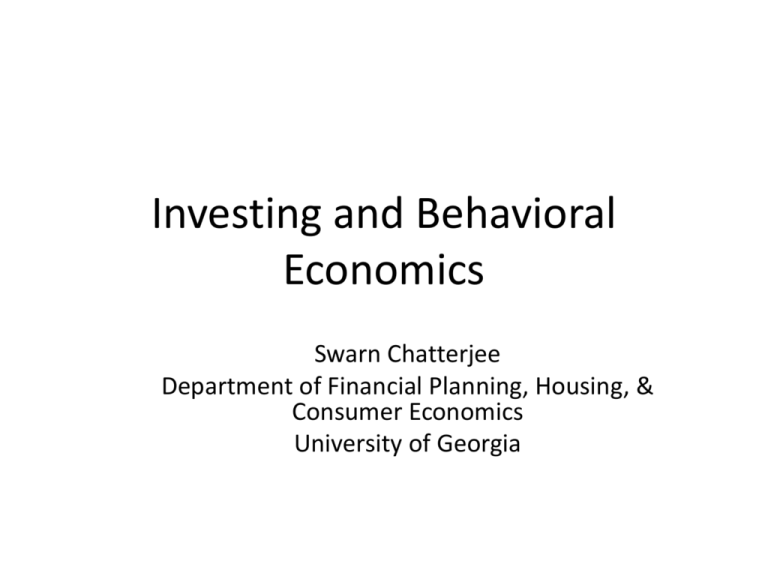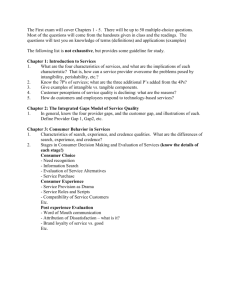Investing and Behavioral Economics
advertisement

Investing and Behavioral Economics Swarn Chatterjee Department of Financial Planning, Housing, & Consumer Economics University of Georgia Topics for today’s discussion • Financial Capability • Behavioral Economics: The role of psychology in financial decision making • Investing principles What is Financial Literacy? • Perceived Competence – How well someone can access, understand, and apply financial information • Measured Competence – A person’s ability to access, understand, and apply financial information when measured on a scale (Nicolini, Cude, & Chatterjee, 2013) What is financial capability • an individual’s capacity based on knowledge, skills, and access, to manage financial resources effectively President’s Council on Financial Capability • Resources • Federal Government’s Resource Guide for financial capability – https://www.whitehouse.gov/sites/default/files/final_toolkit_k-12.pdf – https://www.whitehouse.gov/webform/financial-capability-toolkittell-us-what-you-think • Jumpstart Coalition – http://www.jumpstart.org/assets/files/2015_NationalStandardsBook. pdf Our View of the Financial World • The Concept of ‘Lenses’ – Risk tolerance is a mediating factor – Knowledge • Education • Training • Experience • Current Environment • Recent Events Why financial knowledge matters? Adapted from Grable & Palmer (2015) Why does financial education matter? • Policies resulting in increased individual responsibility in saving for one’s retirement, managing one’s finances • Increasing longevity • Mandatory Auto insurance, health insurance etc. • Complex financial decisions are being shifted from institutions to individuals Characteristics of financially capable individuals • Self-regulation – Self-efficacy (Confidence) – Self-Control • • • • Experience Information (Education) Interest Being involved/engaged in consciously making financial decisions • Altruism Pathways to wealth • Keeping good financial records • Spending less than is earned • Maintaining appropriate risk management strategies – Insurances – Emergency funds • Saving money on a regular basis Savings & Investments • How can we define savings? • How is investing different from saving? Saving vs. Investing • How much do we need to save? • Where should we invest our money? Are people saving enough? • https://research.stlouisfed.org/fred2/series/P SAVERT • http://www.cnbc.com/id/102317918 Applying Behavioral Economics to Improve Financial Well-being • Save more tomorrow (SMT™) program – Thaler & Benartzi, 2004 • Using psychological counseling techniques to reduce financial stress Revisiting our discussion on risk tolerance • What is risk tolerance? • What is risk capacity? • Why is this important? Why is financial risk tolerance a big deal? • Investments in different asset classes require different levels of risk taking • The financial asset classes that are more risky have to offer higher yields (returns) to remain competitive • The amount of return we can generate from the market is tied to the amount of risk we take • The amount of risk we can take in the market is constrained by our risk tolerance What mistakes do people make when investing? Lessons from Behavioral Economics • Prospect Theory (Kahneman & Tversky, 1979) – Risk averse during profitable situations – Risk taking when losing money • Disposition effect (Shefrin, 2001) – Hold on to the poorly performing stocks for too long – Selling off the profitable stocks too quickly • Hyperbolic Discounting (Laibson, 1997) – People in general love to procrastinate • Some do it more than the others Which of these asset classes offer the highest return (and considered riskiest)? • • • • Savings accounts US government bonds Corporate bonds Stocks • Resources: – Stock market games for students – http://www.msmoney.com/2001/12/14/investing_games_ for_kids.htm What increases financial risk tolerance? • A combination of factors: – Experience of investing in financial markets – Educational attainment – Financial education/knowledge – Age – Gender Other interesting facts about risk tolerance • Nobody is born with high financial risk tolerance • Risk taking behavior in other areas of your life does not mean that you are also financially risk taking • Risk tolerance can change—increases with the factors discussed in the previous slide Other interesting facts about risk tolerance • Everything else being equal who accumulates greater wealth across time? – Men or Women? (Barber & Odean, 2001) – Single individuals or Married households How is risk measured? • Perceived risk tolerance – Risk preference • Prefer to be wealthy or poor? If this is an important priority for a person • Measured risk tolerance • What is your risk tolerance? – http://njaes.rutgers.edu:8080/money/riskquiz/ Risk Preference & Wealth • A person’s ability to take risk determines in essence how much wealth she is going to accumulate • A person’s risk preference determines whether he is willing to invest in a certain asset class Sauerkrauts, Kimchis, Investments, & Risk Preference • Investment asset classes are like Sauerkrauts and kimchis – People not familiar with terms like stocks, bonds, mutual funds, etfs, annuities, wills, trusts, & commodities etc. prefer to stay away from them – The more adventurous (risk takers) try them first – For the vast majority of others participation in financial markets come with knowledge and experience How well can people perceive risks? • The vast number of research studies done in this area indicate that we are actually quite terrible at perceiving the riskiness of an asset class Revisiting Human Capital • What is our net worth? – Conventional wisdom is: Net worth=Total assets-Total debt • Your worth from a behavioral finance perspective: – Total Net worth=Net worth + The value of your human capital What is Human Capital? • Income, Educational attainment, Health • Your ability to work, learn, earn, & make rational (wise) financial decisions • Human capital represents your skills, knowledge, and capacity • Human capital increases with: – Education, training, experience, continuing education, & skill development Lifetime earnings by educational attainment Example of a Professional Degree—Financial Planning (Bureau of Labor Statistics, 2014) http://www.bls.gov/ooh/business-and-financial/personal-financial-advisors.htm#tab-1 Basic Computation of the Value of Human Capital Where, • C=Annual income • I=Inflation or rate of increase of income • N=Number of periods The Importance of financial knowledge • Most people are not very good at exchanging their human capital for financial capital • The more efficiently a person can exchange their human capital for financial capital, greater is the wealth they can accumulate across time – Financial knowledge and financial capability is critical for this to happen More on Saving • How much should we be saving? – Depends on our financial goal and our time horizon • Short term savings goals – Emergency funds • Long-term goals – Retirement accounts – Retirement plans – Investment accounts/Brokerage accounts How much should be kept aside as emergency funds? • Conventional Wisdom – Having three to six months of income set aside in an emergency fund • Household Finance Research findings – Varies by profession and source of income • For self-employed individuals the best amount might be closer to six or even twelve months of income in an emergency fund – For those on regular salaried employment, more recently it has been taking about 20 weeks (5 months) to find an equivalent job Common large scale budget breaking expenses aside from job loss How to build an emergency fund? • Setting aside a small amount of money each pay period is the best way to build an emergency fund • Having access to affordable credit (low-rate credit card without a balance) can also provide needed liquidity in an emergency until you have had time to save sufficient money • Because emergencies do not come every year, many individuals find that a combination of emergency funds and low cost access to credit provide the best protection against unexpected events • For example, if your monthly income were $2,000, then you should have access to about $6,000 in case of an emergency – This could consist of $1,500 in savings, plus an unused $4,500 credit line. Where to save for your emergency funds • Keeping it at home is an option – Risks involve safety and security risk, temptation to use the money, does not grow • Savings account – Interest bearing account – Safe & secure – Any savings account that you open with a bank or credit union is insured by the Federal Deposit Insurance Corporation (FDIC) or the National Credit Union Association (NCUA) – Risk: Can be easily accessed & does not protect the investor against the temptation of using the money for a non-emergency consumption Resource: Review Exercise A. Opportunity Cost B. Money market account C. National Credit Union Association D. Certificate of Deposit E. Federal Deposit Insurance Corporation F. Savings Account 1. Insures deposit accounts at banks against loss if the bank becomes insolvent. 2. An interest bearing account providing depositors a safe and secure place for money. 3. The foregone benefit that you would get from doing the next best thing. 4. A savings account that restricts withdrawals from the account until a specific date; in exchange, the depositor receives a higher interest rate. 5. An account that pays higher interest rates than a savings account. 6. Insures deposit accounts at credit unions against loss if the credit union becomes insolvent. Equitization of Emergency Funds • Another method to save and protect your investments that has become popular of late is the equitization of emergency funds – Holding your savings as investments • Preferably in a tax advantaged account like the Roth IRA • Or a taxable account such as a brokerage account How to open a Roth IRA? • Most banks and credit unions will be able to set up a ROTH IRA account at their institution – Some of these ROTH IRA accounts may be limited to one or two types of investments, a CD or money market fund • Investment companies, also assist individuals in opening and contributing to ROTH IRAs – www.vanguard.com – www.fidelity.com – www.charlesschwab.com Other resources for beginning Investors • https://www.loyal3.com/


